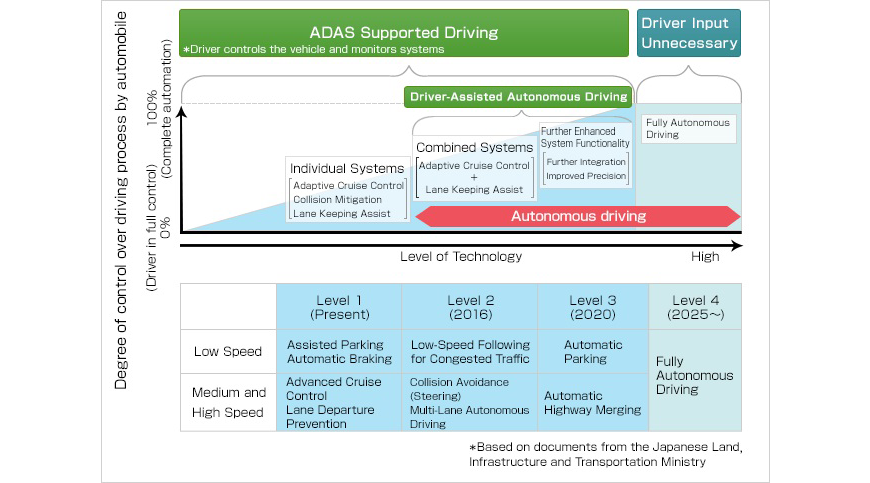Future Technologies
Autonomous Driving Technology
Widening the Horizons of Autonomous Driving with Advanced Driver Assistance Technology
As urbanization and population ageing continues, traffic accident reduction, alleviation of traffic congestion and reduction of environmental load have become important topics not only for the automotive industry but for society as a whole. Recently, ADAS (Advanced Driver Assistance Systems) has emerged as a milestones in the pursuit of these objectives, and as the functions that make up ADAS are becoming increasingly widespread, fully autonomous driving stands on the horizon as the next frontier that will change the way we drive. Current ADAS supported driving is expected to gradually shift towards less human driver participation and eventually evolve into completely autonomous driving with the advent of combined and integrated driver assistance functions.
At the Nidec group we combine the capabilities of our individual companies to shape the future of autonomous driving with advanced sensing devices and recognition algorithms—the keys to bridging the gap between ADAS and fully autonomous driving.

In order to realize autonomous driving, several hurdles must be overcome. First of all, automobiles need to become capable of generating and choosing paths based on environmental sensing. For this to become possible, map data will be a necessary addition to detection of free space based on visual cues provided by road surface markings and curb stones etc. As current GPS technology lacks the accuracy and precision to reliably guide fully autonomous vehicles, SLAM (Simultaneous Localization and Mapping) technology is employed to generate maps and keep track of the automobile based on detection of nearby landmarks. When the automobile starts moving towards its destination after having generated a path, it has to keep track of potential obstacles and decide whether to stop or perform an evasive maneuver when an object appears in its path. Furthermore, some situations—such as curves, changes in inclination or traffic congestion—may necessitate lane changes or merging, making smooth and precise adjustments to speed and steering necessary.
The problems that need to be overcome before autonomous driving can become reality are many and varied. At the Nidec group we are stepping up our research and development of advanced vehicle control technology based on sensors, motors control systems and more—all to make the autonomous vehicles of the future possible today.
